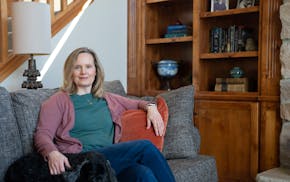Nothing helped Dr. Sarah Freitas regain her spark at work — not therapy, not a rafting retreat in Utah, not a three-month leave to clean her garage and catch up on chores.
The obstetrician would return to practice in Waconia and feel tired every time she haggled on the phone with an insurance company or labored with the electronic medical record system that was supposed to make work easier.
"I never could get out of that hole of being overtired and just angry in the course of my day at all of the stupid stuff," she said.
Freitas left practice in 2022 after 19 years, much earlier than planned, at age 50. She's hardly alone. Burnout is pushing many Minnesota doctors into early retirement, right when an aging population is expected to need more from them.
The problem is gaining attention, including from the Minnesota Legislature, which may spend $250,000 to connect stressed-out doctors to mental health support in an effort to preserve their careers.
"Burnout is associated with things that we don't want, like suboptimal patient care and poorer outcomes," said Dr. Colin West, who directs employee well-being at Mayo Clinic in Rochester. "If we're going to take the best possible care of patients, we need to take the best possible care of the people taking care of our patients,"
Burnout has been recognized for two decades, but it erupted during the pandemic. Doctors felt purpose early on, when they raced to treat the first wave of COVID-19 patients, West said, but confronting so many deaths and patients who quarreled over COVID treatments and vaccines wore them down.
Doctors out of necessity relied on online conferencing and e-messaging to keep tabs on patients during the pandemic, but the continued use of those tools after the public health emergency left them feeling disconnected and buried in email replies.
West and colleagues just published survey results showing 63% of doctors had burnout symptoms, such as emotional exhaustion and cynicism, at the pandemic's peak in 2021. The rate declined to 42% in 2023, but was still higher than the burnout rate in most pre-pandemic years. And doctors reported more problems with work-life balance than other workers.
Almost one in five doctors plans to stop practicing medicine within five years, according to a workforce survey by the Minnesota Department of Health. Reaching retirement age was the most common reason, but feeling burned out was second.
Freitas graduated from medical school and then completed on-the-job residency training in Indiana in 2002 — an era when young doctors were pushed hard. A year later, the Accreditation Council for Graduate Medical Education recognized the risks of overworking residents and capped their average work weeks at 80 hours.
"We were trained to keep going until you can't go anymore, and then keep going after that," she said.
Freitas said her patients kept her energized. Getting a call that one of them was in labor was an adrenaline rush. She would hustle across the street from her clinic to Ridgeview Medical Center in Waconia for the delivery.
Joy faded, she said, as she encountered less face time with patients and more e-visits, insurance authorizations and paperwork. She didn't sleep well, either, trained to expect a call at any hour. Then her parents died, and she lamented that work prevented her from being available for them. She was missing moments in the lives of her three teenagers as well.
"Classic midlife things," she said. Freitas announced that she was retiring in 2022, but stuck around for six months to say goodbye to patients and give her group practice time to replace her.
On paper, Minnesota isn't losing doctors; the state's Board of Medical Practice reported 29,000 licensed physicians last June, up from 22,000 a decade earlier. But the numbers can be deceiving. Freitas kept her license, for example, in case she wants to return.
Other doctors are reducing hours and seeing fewer patients. And the growth in licensed physicians is being outpaced by the growth in baby boomers who have reached their 60s and 70s and expect to need more medical care soon.
Already, doctors are seeing a "gray tsunami" of older patients from this massive generation with complex conditions that take longer to treat, said Dr. Natalia Dorf Biderman, who directs provider well-being for Bloomington-based HealthPartners. "The demand for care, it really is increasing significantly."
Dorf Biderman and West are leading efforts by the Minnesota Medical Association, an advocacy group for physicians, to reduce burnout statewide. Their efforts prompted a recent state ban on hospitals asking about old, unrelated mental health issues before issuing credentials to doctors. Doctors are hesitant enough to seek care, West said, without fearing that it will make it harder to get licenses or credentials in the future.
The medical association also launched the Treat Yourself First campaign to encourage doctors to seek help. The proposed legislative funding would support this campaign.
Minneapolis-based Allina Health surveyed its doctors and found in 2022 that they linked their burnout to a loss of autonomy as they were required to respond to patient emails and conduct more electronic recordkeeping, all while maximizing patient visits.
Responses improved in 2024 after the health system made changes, said Dr. Mary Beth Lardizabal, medical director for Allina's Center for Provider Well Being. Allina paid doctors to respond to patient messages while colleagues were on vacation, cutting down on paperwork when they returned.
Allina also is using artificial intelligence to summarize notes of patient visits, and providing doctors with peer support to talk about the hardships of their profession, along with therapeutic services.
"Its OK to not be OK," Lardizabal said. "For a doctor, that is really, really hard, because you are supposed to be perfect. You're supposed to never make a mistake."
Dr. Laura Slings' solution was to leave her Allina group practice and create True North, a direct primary care clinic in White Bear Lake where patients pay membership fees for year-round care and don't bill insurance. She traded in one source of stress for another, taking a financial risk and doing everything in her clinic from drawing blood to performing tests to dispensing medications.
"My husband faxes all the orders," she said.
But she said the ability to give more time to her patients has been invigorating.
Burnout played a role in more than 500 doctors at 60 Allina clinics joining a union in 2023. Dr. Matt Hoffman, who led the organizing campaign, said a typical day at his Allina Vadnais Heights clinic might involve 16 to 18 patients, followed by dinner at home, followed by hours at night catching up on paperwork and patient emails.
"We're trying to make sure that time is really paid for," said Hoffman, who managed his own work stress by reducing visits by one to two patients per day and taking a lunch outside the clinic.
Freitas said she tried everything. But in the end, she had to retire from medicine.
The quiet time at home was unnerving at first, but she learned to embrace it after many hectic years. She took a dance class and taught herself the ukulele.
Maybe with time, she said, she will return to a career that is "health care adjacent" or practice part time.
"I needed to have the time away," she said. "It was death by 1,000 cuts."
Minneapolis-based Lemonada Media behind Markle podcast bought by Swedish company

Can Minnesota stop the exodus of burned-out doctors in time?

Target CEO acknowledges silence from leadership has created uncertainty among workers

Minnesota to hold first lotteries for cannabis business licenses in June

